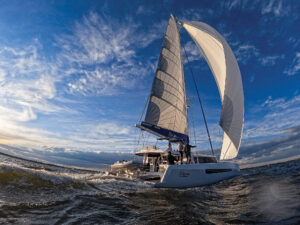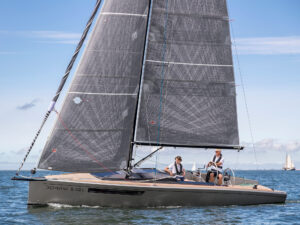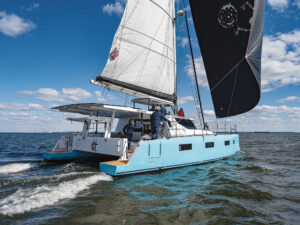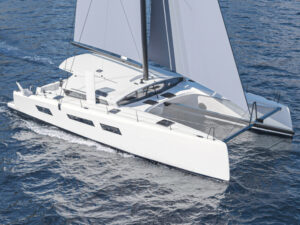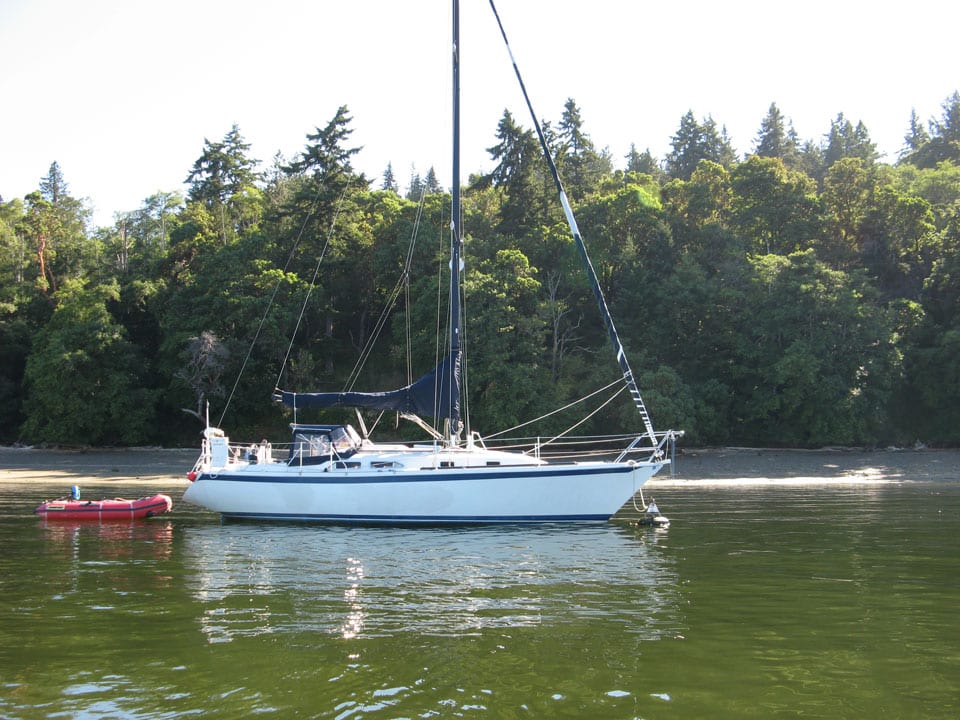
Ericson 32-3
Bruce King’s considerable experience designing sailboats in the 30-foot range shows through in the sailing qualities, accommodations, and construction of the Ericson 32-3.
The 32-3 was introduced in 1985, and at least 69 were built, some of them at Pacific Seacraft after the demise of Ericson Yachts in 1990. It shares a family resemblance with other Ericson cruiser/racers designed by King and extended the company’s reputation for building attractive, practical boats with good sailing manners.
A keel-stepped, black, anodized mast, tapered at the top to reduce weight and windage, supports the double-spreader masthead rig. The 207-square-foot mainsail drives the boat well in both cruising and racing modes. The boat is well balanced and sails both on and off the wind smartly under headsail only, making it easy to singlehand, especially with roller furling.
The large cockpit has a curved helmsman’s perch, which compensates for varying degrees of heel, and comfortably angled seatbacks for the crew. A boarding ladder is built into the stern pulpit. Copious storage is to be had under the starboard seat and in a lazarette. Hardware is more than adequate and includes Lewmar deck hatches, an acrylic companionway sliding hatch, stainless-steel guard rails at the mast, and four 10-inch aluminum mooring cleats.
The construction of the Ericson 32-3 is robust. The hull is hand-laid fiberglass and polyester resin, and the deck is fiberglass cored with end-grain balsa. A one-piece structural inner liner of hand-laminated fiberglass incorporates floors and stringers, adding strength to the hull and distributing concentrated loads from the engine, mast, and standing rigging.
Below, the first impression is one of quality and refinement highlighted by expansive use of teak. The sole is teak and holly. The U-shaped galley is located to starboard of the companionway ladder. Opposite is a forward-facing nav table; its seat is the head of the quarter berth.
In the saloon, which has 6 feet 2 inches of headroom, a teak table surrounded by large wraparound seats folds down to form a double berth. A long settee to starboard makes it a very social space.
The V-berth in the forward cabin is as wide at the head as it is long—6 feet 6 inches—and contains lots of storage space under hatches and in drawers. The head is aft of this cabin to port and contains the toilet, a sink, storage, and a shower.
Removing the companionway ladder provides excellent access to the engine. Original equipment was a 21-horsepower Universal diesel, which delivers a cruising speed of a little over 6 knots while burning about half a gallon of fuel per hour. The boat is unusually quiet under power.
While the usual caveats apply regarding leaks around deck fittings, water penetrating the core material, and so forth, it’s difficult to fault this boat as cruiser or racer. One owner noted that the rudderstock stuffing box is difficult to service and that the original white paint coating the hull interior has an annoying tendency to flake off.
Having owned several Ericsons, I think the 32-3 meets or exceeds the highest standards of construction, predictable handling, and sensible layouts with which Ericson established its reputation. It ghosts along nicely in light breezes and, handled well and with prudent reefing, will stand up to heavy weather. It’s comfortable to live aboard, weatherly, and forgiving in a jam. Used boats are listed from $22,000 to $45,000.
Ericson 32-3
LOA 32′ 6″ (9.91 m.)
LWL 25′ 10″ (7.87 m.)
Beam 10′ 10″ (3.30 m.)
Draft (standard) 6′ 0″ (1.83 m.)
(shoal) 4′ 4″ (1.32 m.)
Sail Area (100%) 497 sq. ft. (46.2 sq. m.)
Ballast 4,200 lb. (1,905 kg.)
Displacement 9,800 lb. (4,444 kg.)
Ballast/D .43
D/L 254
SA/D 17.4
Water 33 gal. (125 l.)
Fuel 22 gal. (83 l.)
Engine 21-hp. Universal diesel
Designer Bruce King
Richard Smith and his wife, Beth, sail their Ericson Cruising 31, Kuma, in the Pacific Northwest.

